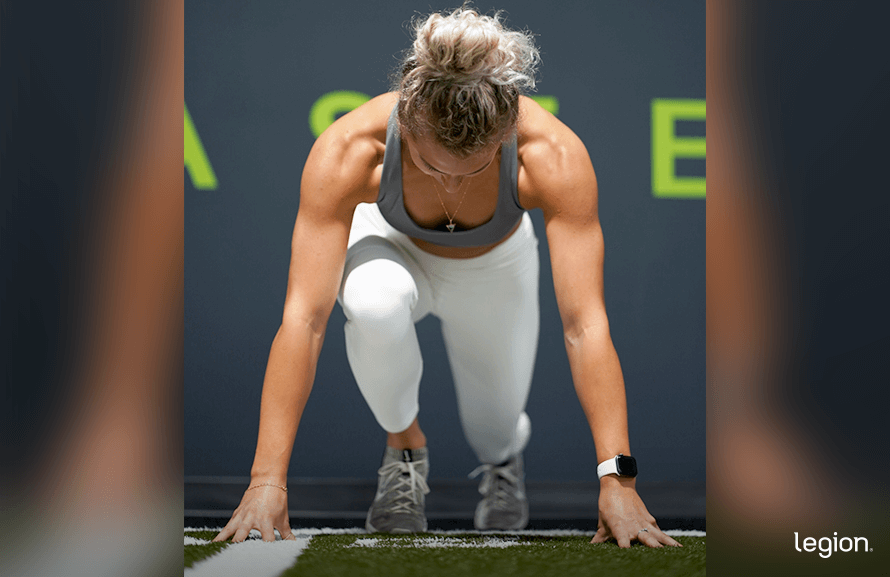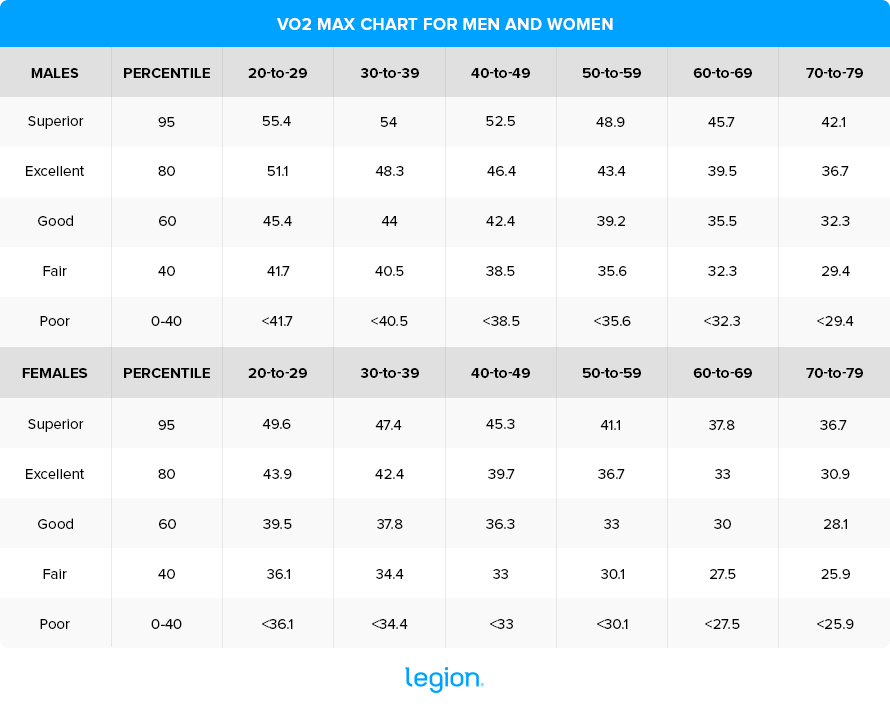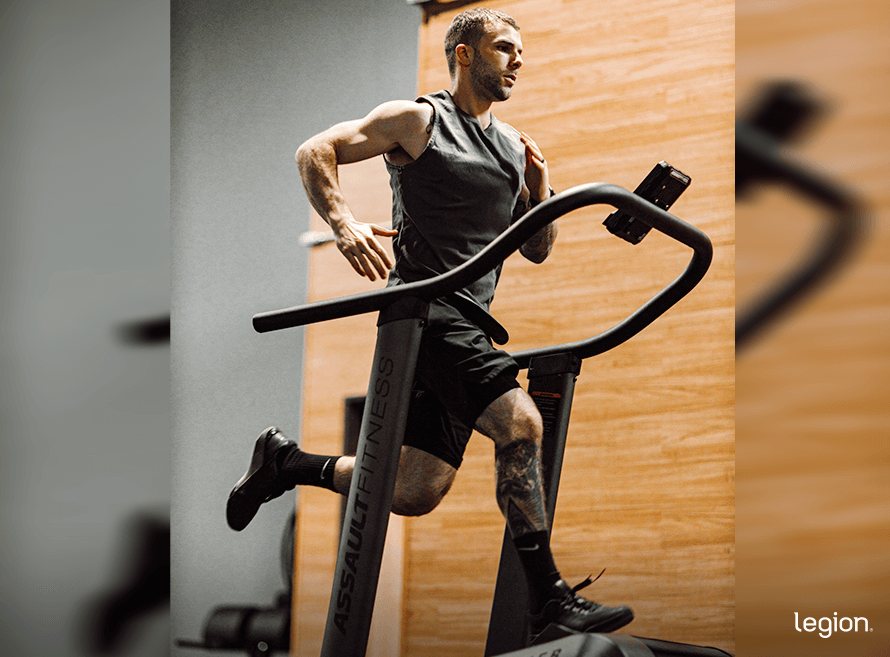The Legion VO₂ Max Calculator estimates your VO₂ max—an indicator of how efficiently your body uses oxygen during exercise and a reliable measure of cardiovascular fitness. Unlike most VO₂ max calculators, ours provides accurate, evidence-based results using simple field tests you can do on your own, without any special equipment. In most cases, all you need is your phone and a bit of space to move.
What Is VO₂ Max?

VO₂ max, or “maximum oxygen uptake,” is the highest amount of oxygen your body can use during intense exercise. It’s measured in milliliters of oxygen per minute per kilogram of body weight (mL/kg/min).
Why Is VO₂ Max Important?

Oxygen is essential for producing adenosine triphosphate (ATP), the energy source your body uses to power all cellular activity.
During aerobic activity, your body uses oxygen to convert glucose, glycogen, and fat into ATP to keep your muscles working.
The higher your VO₂ max, the more oxygen your heart can deliver to your muscles, allowing your body to produce more energy and sustain activity for longer—resulting in better endurance performance.
VO₂ max is also linked to longevity. Research shows that having a higher VO₂ max is associated with a lower risk of chronic diseases and a longer lifespan.
VO₂ Max by Age
VO₂ max declines with age, which is why fitness standards differ across age groups.
The chart below shows how VO₂ max scores compare by age and sex, broken down into percentile categories from “poor” to “superior.”
To see where you fall, find your age range and match your score to the appropriate column.
Breaking down VO₂ max by age gives you a clear sense of how your cardiovascular fitness compares to others in your demographic.

How to Increase Your VO₂ Max

Below are three training strategies to boost your VO₂ max.
Each requires you to train at different percentages of your maximum heart rate (the fastest rate your heart can beat in one minute, also called “MHR”).
To use percentages of your MHR in your training, here’s what you need to do:
- Determine Your MHR: Estimate your MHR by subtracting your age from 220. For example, if you are 30 years old, your estimated MHR would be 190 beats per minute (bpm).
- Calculate Training Intensity: Divide the intensity percentage by 100, then multiply the answer by your MHR. For instance, if the workout requires 80% intensity and your MHR is 190 bpm, do the following math: (80 ÷ 100) x 190 = 152 bpm.
- Monitor Your Heart Rate: Use a heart rate monitor during workouts to stay within the target range.
Now let’s discuss the strategies.
1. Do high-intensity interval training.
Doing high-intensity interval training (HIIT) is crucial for improving VO₂ max.
Unlike typical HIIT workouts, where intervals are relatively short (usually measured in seconds), intervals should be slightly longer when training to improve VO₂ max (usually 3–8 minutes).
A solid starting point is the “4 x 4” method: Do 4 minutes of cardio (running, swimming, cycling, etc.) at about 90% of MHR, followed by 3 minutes of active recovery at 50–70% of MHR. Repeat 4 times for a total of 28 minutes of exercise.
To limit fatigue, do these workouts once weekly. As you progress, lengthen the intervals or increase the number of rounds to continue challenging yourself.
READ MORE: The Best HIIT Workouts for Weight Loss
2. Do low-intensity steady-state workouts.
While many people focus solely on HIIT to improve VO₂ max, it’s only part of the puzzle. To see the best results, you also need longer, lower-intensity workouts—often called “zone 2” training—done at 60–70% of MHR.
Aim for 2–3 zone 2 sessions per week, each lasting 30–45 minutes.
3. Incorporate tempo runs.
For experienced runners, tempo runs—or “threshold” runs—are another effective way to improve VO₂ max. During a tempo run, you keep your heart rate at around 80% of MHR for a sustained period.
This type of training raises your lactate threshold—the point at which lactate starts to build up faster than your body can clear it—allowing your muscles to keep working efficiently even when fatigued.
A higher lactate threshold often goes hand-in-hand with a higher VO₂ max because it helps you maintain intense efforts for longer.
Here’s an example tempo run workout:
- Warm-up: 3 minutes
- Zone 2 pace: 10 minutes
- Tempo pace: 20–30 minutes
- Zone 2 pace: 10 minutes
If you’re an experienced endurance athlete, do a tempo run workout every 1–3 weeks.
FAQ #1: What is a good VO₂ max?
A “good” VO₂ max depends on your age and sex, since scores naturally decline as you get older.
In general, anything above the 60th percentile is considered good and reflects above-average cardiovascular fitness.
When you use the Legion VO₂ Max Calculator, it will tell you whether your result is rated as “good,” “excellent,” or “superior” based on your age and sex. You can also get that information from the chart in the VO₂ Max by Age section above.
FAQ #2: How do you calculate VO₂ max?
The most accurate way to calculate VO₂ max is in a lab using specialized equipment. That said, this method isn’t accessible, convenient, or affordable for many people, so using “field tests” usually works better.
These tests involve activities like walking, running, or stepping and use your time, distance, heart rate, or a combination of these to estimate how efficiently your body uses oxygen.
The Legion VO₂ Max Calculator uses scientifically validated equations based on these field tests to give you a reliable estimate without any special equipment.
FAQ #3: Why is my VO₂ max decreasing?
Your VO₂ max may be decreasing for one of the following common reasons:
- You don’t train as hard or often as you used to.
- You’re getting older (VO₂ max naturally declines with age).
- You’ve taken time off due to injury, illness, or lifestyle changes.
- You’re under more stress, not sleeping well, or not recovering properly.
The good news is that VO₂ max is highly trainable. With the right training, you can usually regain lost ground and improve it over time.
FAQ #4: Why is my VO₂ max so low?
A low VO₂ max usually means your body doesn’t use oxygen efficiently during exercise. It can happen if you’re new to training, haven’t done much cardio lately, or are recovering from an illness or injury. Factors like age, genetics, and body composition can also play a role.
The good news is that you can significantly improve your VO₂ max with consistent training that includes both HIIT and zone 2 workouts.
FAQ #5: How long does it take to improve VO₂ max?
It depends on your current fitness level. Beginners and those getting back into exercise may see improvements in VO₂ max in as little as 4 weeks of regular training.
On the other hand, if you’re already in good shape, increasing your VO₂ max might take longer and require progressively more challenging training over several months or even years.
Scientific References +
- Mandsager, Kyle, et al. “Association of Cardiorespiratory Fitness with Long-Term Mortality among Adults Undergoing Exercise Treadmill Testing.” JAMA Network Open, vol. 1, no. 6, 19 Oct. 2018, p. e183605, jamanetwork.com/journals/jamanetworkopen/fullarticle/2707428, https://doi.org/10.1001/jamanetworkopen.2018.3605.
- Clausen, Johan S. R., et al. “Midlife Cardiorespiratory Fitness and the Long-Term Risk of Mortality: 46 Years of Follow-Up.” Journal of the American College of Cardiology, vol. 72, no. 9, 28 Aug. 2018, pp. 987–995, www.sciencedirect.com/science/article/pii/S0735109718353786?via%3Dihub, https://doi.org/10.1016/j.jacc.2018.06.045.
- Seffrin, Aldo, et al. ““Impact of Aging on Maximal Oxygen Uptake Adjusted for Lower Limb Lean Mass, Total Body Mass, and Absolute Values in Runners.”” GeroScience, 26 May 2023, pp. 1–9, pubmed.ncbi.nlm.nih.gov/37233883/, https://doi.org/10.1007/s11357-023-00828-z. Accessed 16 Oct. 2023.
- Bacon, Andrew P., et al. “VO2max Trainability and High Intensity Interval Training in Humans: A Meta-Analysis.” PLoS ONE, vol. 8, no. 9, 16 Sept. 2013, p. e73182, www.ncbi.nlm.nih.gov/pmc/articles/PMC3774727/, https://doi.org/10.1371/journal.pone.0073182.
- Tjønna, Arnt Erik, et al. “Low- and High-Volume of Intensive Endurance Training Significantly Improves Maximal Oxygen Uptake after 10-Weeks of Training in Healthy Men.” PLoS ONE, vol. 8, no. 5, 29 May 2013, p. e65382, https://doi.org/10.1371/journal.pone.0065382.
- SCRIBBANS, TRISHA D, et al. “The Effect of Training Intensity on VO2max in Young Healthy Adults: A Meta-Regression and Meta-Analysis.” International Journal of Exercise Science, vol. 9, no. 2, Apr. 2016, p. 230, pmc.ncbi.nlm.nih.gov/articles/PMC4836566/.
- FRANCH, JESPER, et al. “Improved Running Economy Following Intensified Training Correlates with Reduced Ventilatory Demands.” Medicine& Science in Sports & Exercise, vol. 30, no. 8, Aug. 1998, pp. 1250–1256, https://doi.org/10.1097/00005768-199808000-00011.
